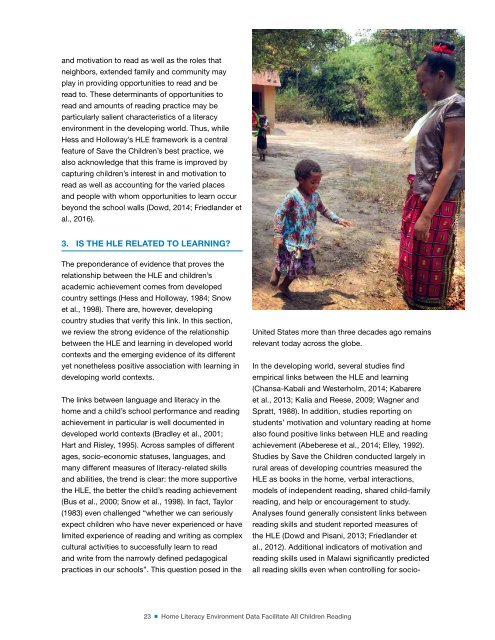UNDERSTANDING WHAT WORKS IN ORAL READING ASSESSMENTS
MZhk301yPHZ
MZhk301yPHZ
Create successful ePaper yourself
Turn your PDF publications into a flip-book with our unique Google optimized e-Paper software.
and motivation to read as well as the roles that<br />
neighbors, extended family and community may<br />
play in providing opportunities to read and be<br />
read to. These determinants of opportunities to<br />
read and amounts of reading practice may be<br />
particularly salient characteristics of a literacy<br />
environment in the developing world. Thus, while<br />
Hess and Holloway’s HLE framework is a central<br />
feature of Save the Children’s best practice, we<br />
also acknowledge that this frame is improved by<br />
capturing children’s interest in and motivation to<br />
read as well as accounting for the varied places<br />
and people with whom opportunities to learn occur<br />
beyond the school walls (Dowd, 2014; Friedlander et<br />
al., 2016).<br />
3. IS THE HLE RELATED TO LEARN<strong>IN</strong>G?<br />
The preponderance of evidence that proves the<br />
relationship between the HLE and children’s<br />
academic achievement comes from developed<br />
country settings (Hess and Holloway, 1984; Snow<br />
et al., 1998). There are, however, developing<br />
country studies that verify this link. In this section,<br />
we review the strong evidence of the relationship<br />
between the HLE and learning in developed world<br />
contexts and the emerging evidence of its different<br />
yet nonetheless positive association with learning in<br />
developing world contexts.<br />
The links between language and literacy in the<br />
home and a child’s school performance and reading<br />
achievement in particular is well documented in<br />
developed world contexts (Bradley et al., 2001;<br />
Hart and Risley, 1995). Across samples of different<br />
ages, socio-economic statuses, languages, and<br />
many different measures of literacy-related skills<br />
and abilities, the trend is clear: the more supportive<br />
the HLE, the better the child’s reading achievement<br />
(Bus et al., 2000; Snow et al., 1998). In fact, Taylor<br />
(1983) even challenged “whether we can seriously<br />
expect children who have never experienced or have<br />
limited experience of reading and writing as complex<br />
cultural activities to successfully learn to read<br />
and write from the narrowly defined pedagogical<br />
practices in our schools”. This question posed in the<br />
United States more than three decades ago remains<br />
relevant today across the globe.<br />
In the developing world, several studies find<br />
empirical links between the HLE and learning<br />
(Chansa-Kabali and Westerholm, 2014; Kabarere<br />
et al., 2013; Kalia and Reese, 2009; Wagner and<br />
Spratt, 1988). In addition, studies reporting on<br />
students’ motivation and voluntary reading at home<br />
also found positive links between HLE and reading<br />
achievement (Abeberese et al., 2014; Elley, 1992).<br />
Studies by Save the Children conducted largely in<br />
rural areas of developing countries measured the<br />
HLE as books in the home, verbal interactions,<br />
models of independent reading, shared child-family<br />
reading, and help or encouragement to study.<br />
Analyses found generally consistent links between<br />
reading skills and student reported measures of<br />
the HLE (Dowd and Pisani, 2013; Friedlander et<br />
al., 2012). Additional indicators of motivation and<br />
reading skills used in Malawi significantly predicted<br />
all reading skills even when controlling for socio-<br />
© Lauren Pisani, Save the Children<br />
23 ■ Home Literacy Environment Data Facilitate All Children Reading



